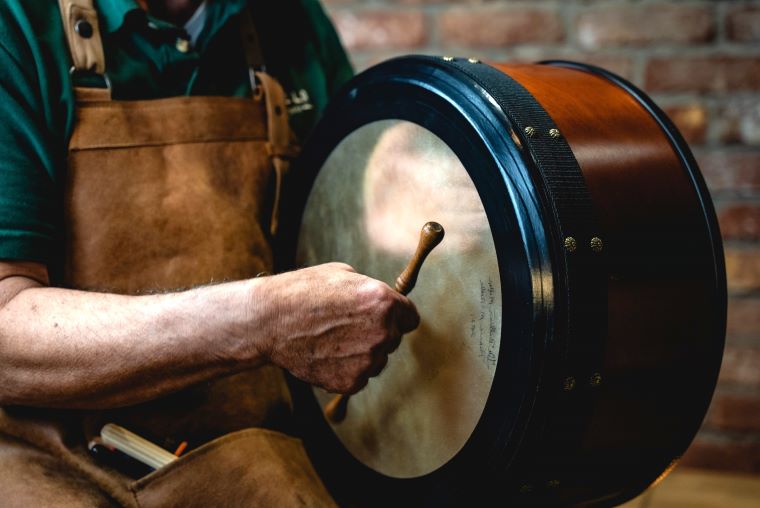
Peadar Merceir of The Chieftains once said of famed Irish composer Sean O’ Riada playing the bodhran:
‘I think he liked the rhythm of it, he liked the compelling attraction of it, and he played it with great skill…. he led the group with the bodhran and that is the one and only time the bodhran took pride of place over the total ensemble’
O’ Riada was classically trained and formed the folk group Ceoltoiri Chualann. He retrieved the bodhran from history and restored its presence in Irish music during the 1960s, placing it as a rhythm tool underneath melody to keep time and signal the end of a phrase or a transition in play.
For the uninitiated, the bodhran is a frame drum with a skin head that is played with the hand or a cipin (tipper/beater). The other hand is placed at the back of the skin for tonal change. Today, the bodhran continues to hold attraction for those who wish to participate in Irish music or simply connect to their Irish heritage.
The bodhran’s place within Irish culture goes beyond written or verbal history to one of the most ancient forms of communication – sound.
In his article ‘Different Drums, Same Groove’ (2015), Tyler Stark highlights the transition of the bodhran from ensemble timekeeper, building on pulse and tonal sounds, to the establishment of the instrument as an independent voice that adds another dimension to ensemble playing. This evolution makes it possible for percussionists to place themselves in moments of Irish tradition in sight of standing on the shoulders of giants.
O’ Riada recognized the mesmeric qualities of the bodhran; this much is evident in Mercier’s comments. He will have noted the context of the bodhran, whose lineage is that of the ancient practice of drums in festivals and battles. Noted for its ability to connect those around them to a common purpose, it brings a single point of focus to the mind. Herein lies the secret of the bodhran- its ability to induce a quiet meditative state, to foster rapport between drum, player, and listener, and to entrain the mind to a state of peaceful awareness creating the experience of making and playing Irish music. ‘The drum can ‘connect us with the quiet intelligence beneath the mind’.
This is the point at which intuition and improvisation, qualities that dwell at the centre of Irish music, can emerge.
Both features characterise Irish musical tradition in its continuing story within the framework of simple repetitive rhythm. As the rhythm of the drum creates deeper levels of absorption, repetitive beats develop a particular quality of listening that exists in free improvisation. A transition takes place that enables the player to move into a flow state in which tension dissolves and the lens of perception broadens to encompass both the detail of play simultaneously with the music as a whole.

The sound and rhythm of the bodhran, like other drums, results in the alignment of internal bodily processes, such as heart rate and breathing. ‘It is this synchronicity that creates unity with the bodhran enabling a player to be at ‘one with the rhythm.’ Alpha and theta become the predominant brainwaves, leading to a relaxed wakeful state in which deep listening occurs – circumstances that generate the capacity for intelligent use of intuition and improvisation. Moments become elongated as clock time moves to Kavological time, (Greek for ‘right moment to decide’), the percussionist shifts into the language of sound and music.
This begets an awareness of both the sound of the bodhran, and also the spaces between the beats – the silence from which the sound arises and returns.
The music is not in the notes but in the silence between (Mozart 1756-1792)
Many artists have paid homage to Mozart’s view, using the space between to create, improvise, and heighten communication in music. Jazz pianist Ahmad Jamal is famous for his use of silence between notes to raise tension and build anticipation for the audience. This place is not simply an empty gap for music, but a place where rhythm can be used to draw the listener in further, for a more intimate experience, and one that touches the Celtic soul and releases the ‘pan within’
The bodhran has travelled its own evolutionary journey since O’ Riada pressed the light switch that illuminated its powers. The introduction of drum set patterns, clicks, fills, and rim shots have made it worthy of collaboration with a range of unexpected instruments.
The bodhran landscape has evolved over time as influences from other countries and cultures bring forth unique and unusual time signatures.
And it continues to assert its presence in current Irish music as players such as Joe Kelly of Flook demonstrate its versatility and relevance.
But whilst O’Riada rescued the Bodhran from historical obscurity, its survival into the new age of Irish traditional music may depend on the ability of new and established percussionists to use the meditative qualities of the drum to bring silence to sound. They are called to reject the boundary of ‘bam bam’ and unlock the quiet space that the drum provides for deep listening, connection with quiet intelligence, intuition, and improvisation. The gift lies within the bodhran itself; it merely requires the player to look up from the ‘bam bam’ to bring intentional awareness to the beat of the drum and the silence it offers. By honouring the ordinary magic that is the mesmeric power of the bodhran, musicians can play a part in its journey, since all that is new and improvised today, becomes authentic heritage with the passage of time.




















Leave a Comment